
After attending the International Preksha Meditation Camp in Ladnun, Rajasthan, I had plenty of free time to explore the surroundings and step-by-step get in touch with what I afterwards called “the real India”.
Thanks to the kind invitation of the Department of Social Work of Jain Vishva Bharati Institute, led by Professor Musafir Singh and assisted by Professor Pratibha J.Mishra, I had the unique opportunity to accompany the students on their visit to the villages and farms around Ladnun, where they perform their activities.
Before describing my experiences I would like to praise the importance of the Social Assistant’s work on behalf of the rural population, it is a huge task they undertake with enthusiasm and abnegation in spite of the limited means available, trying to improve life standards, modernize customs and also upbringing the status of the women on that society.
There are several Teams, each one led by a senior student, and each Team is assigned to a different village. Twice a week on the afternoon they jump on the University bus and face the bumps, dust and heat of the one-hour journey to distribute the Teams around. I rode with them in some of these journeys…
Shimla
After gathering at the University Square we set to Shimla village with Mr. Bibbins Team and Carlos Rodriguez Leiva, the Spaniard teacher and only other foreigner. First driving thru Ladnun, then along the rail tracks outside the city and in to the fields. As many other villages around Ladnun, Shimla is very poor, consisting of some farm houses scattered around fields which by this time of the year are mostly dry, the ever present cows and peacocks, barely a person to be seen, the temple and the school, attended by children from 7 to 11 years old.
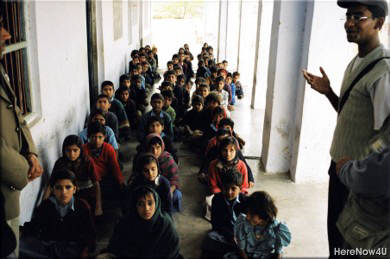
Shimla students and Mr. Bibbins
At the school we had a touching experience in the form of poems and songs performed especially for us by the children. They did not know about my visit beforehand and the performances were all spontaneous. Then thru a translator they asked us questions about the place we came from etc…and in the end we addressed them some words. I was struck by the beauty of some children, wonderfully eyed. In the meanwhile the Social Workers went around to check their duties and afterwards we met at the village’s social centre, where we were given a nice meal consisting of locally made dark bread and buffalo milk yoghurt. Soon it was 18:00 and we heard the bus horn blowing outside, time to go back.
Shiampura
Today we went to Shiampura village and this was a special occasion for the students had organized a big event consisting of sketches performed by the village’s youngsters and children, dealing mostly with current social problems such as children marriage, drugs and alcohol consumption, the role of the women, corruption etc…and also typical folk dances. All Teams joined together for this work.
Shiampura is bigger than Shimla and upon arriving we were immediately surrounded by people, most of them had never seen a foreigner before, but in spite of the language barrier they were all eager to communicate and at least to shake hands with us. One very old man approached and explained he had been in the army during the war therefore he could speak some English and it was an honour for him to meet us.
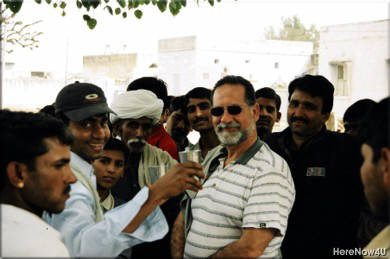
Welcome at Shiampura - Mr.Bibbins and Carlos
Out of nowhere came glasses of lassy, the local made beverage…
We did a quick tour around to see the village, the temple and the ubiquitous Holy tree.
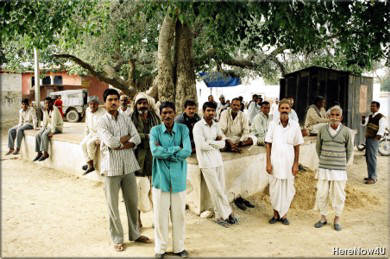
Shiampura villagers around the Holy Tree
There was a stage set on the main square and people started to sit on the floor around it under a scorching sun, men on one side, women on the other. The stage
It was time for the show to begin and we were given a place of honour together with Prof. Singh, Prof. Pratihba and other members of the University as well as the head of the village, which in this case was a woman. (During the performances she quietly withdrew to her fellow women villagers on the floor and was then officially represented by her husband).
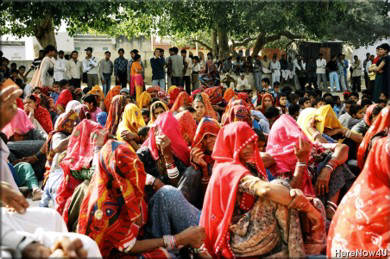
Shiampura women
We were also presented with a collar of flowers, a symbol of distinction that we wore around our necks until the end of the ceremony, although all the Indian personalities present dropped theirs as a sign of humility.
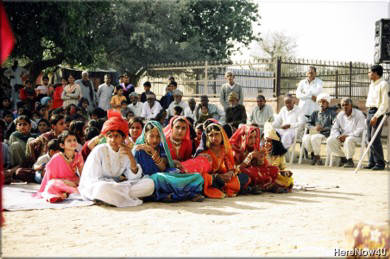
Some of the performers
Then it was speech time and after proffering his, Prof. Singh invited us to address some words to the people. It was a touching experience and I felt honoured with such an opportunity. It was nearly dark when we started for the bus again and back to our quarters at Needam (JVB Ladnun), all along the way people came to shake hands and bade farewell. We were tired but with the heart full of joy of being among such simple, friendly and nice people.
[to becontinued]